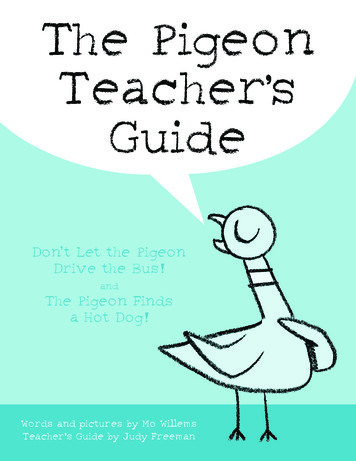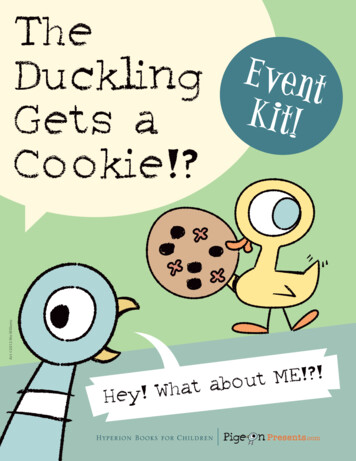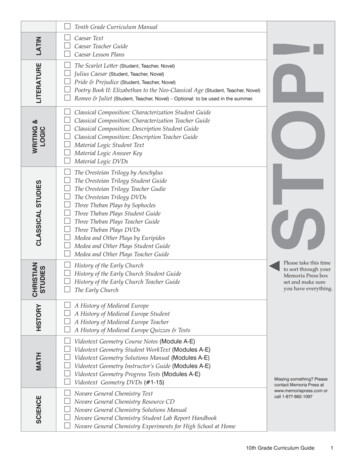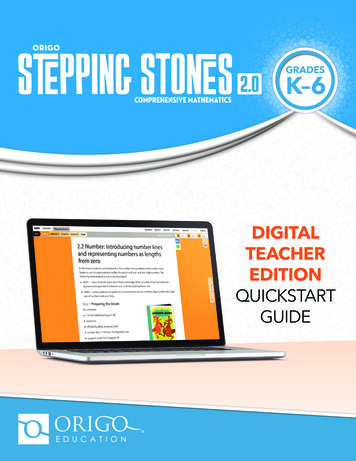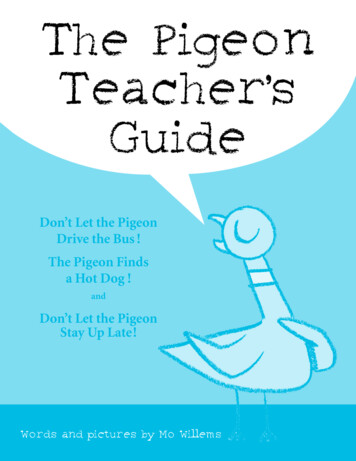
Transcription
The PigeonTeacher sGuideDon’t Let the PigeonDrive the Bus !The Pigeon Findsa Hot Dog !andDon’t Let the PigeonStay Up Late!Words and pictures by Mo Willems
C mon,say itloud:Don t Let thePigeon Drivethe Bus!ACT IT OUT:Have your group stand up and act out the Pigeon’srole, emulating his dialogue and especially his bodylanguage as he shifts through a masterful range ofemotions. He is eager, hopeful, cajoling, annoyed,joyful, deflated, doubtful, exasperated; finally heerupts in a full-blown tantrum: “LET ME DRIVETHE BUS!!!” Examine and analyze the wonderfullyevocative tantrum page, with the explosive yellow andblack lettering, flying feathers, and six images ofPigeon having a meltdown, and then ask your actorsto re-create the scene. Ask them if they can recall everhaving had a tantrum and what it felt like.LET MEDRIVE THEBUS!!!!!Though the bus driver has warned us, “. . . Don’t let the pigeon drive thebus!” the jaunty blue Pigeon uses every trick in the book, from whining totemper tantrums, to convince us, the readers, to let him do just that.INTERACTING WITH THE BOOK:What’s hilarious about this picture book for all ages is watching thatpigeon try to talk us into something forbidden, just as childrendo every day. “Hey, can I drive the bus?” the gimlet-eyed bluepigeon asks you, the reader, straight out. “NO!!!” your listeners willspontaneously reply. They will most likely decide there is no waythey will let that pigeon drive that bus.GET TO KNOWTHE PIGEON:With your group of children, compile a listof words that describe each of his emotions.Next, list words that describe the Pigeon’spersonality. They can draw a picture of thePigeon to go along with one or more ofthose words. Examine the illustrations, anddescribe how the Pigeon’s face was drawn toexpress each emotion.And aren’t these same kids begging and pleading with their own authority figures to let them stay up late and do forbidden stuff? You might thinkyour young listeners will empathize with the poor Pigeon and let him drive,but you will most likely be amazed by how adamant they are.The youngest children can read the pictures and the moods of the Pigeonas he tries to fast-talk us into letting down our guard. As you read the bookaloud, acknowledge your listeners’ spontaneous responses (“NO!” “Forgetit!”) as they interact and answer back each of the Pigeon’s entreaties.I likesunsets,long walkson the beach,and drivingbuses. . . .CALDECOTT HONOR:The Caldecott Honor, or silver medal, is given each year to the artistsof the year’s most distinguished American picture books for children.Some readers may look at Willems’s books and call them deceptivelysimple. Willems agrees, but with some clarification.Dear Mr.Bus Driver,How are you?How isyour bus?“I’d tweak that to ‘deliberately simple’, ” he says. “The essence of my designis to create an immediate, emotional connection . . . I’m thrilled that anychild can pick up a crayon and quickly create a reasonable drawing ofPigeon; it allows the book to connect with the reader on a fundamental,participatory level.”Your friend,PigeonDiscuss with your students:Why do you think the Caldecott Committee chose this book?What is special or memorable about the illustrations?Art 2006 by Mo WillemsWRITE ABOUT IT:For older children, what is this? It’s a monologue,though one that encourages the person on the outsideof the story to interact and respond. Read the storyaloud again, and have the children answer each of thePigeon’s entreaties out loud (or in writing), givinga variety of good reasons for each response. What afabulous showcase for persuasive writing, one of themany forms writing teachers introduce and model!Ask your students to write a persuasive letter to thebus driver, with clear reasons why the Pigeon should,or should not, be allowed to drive. Or have them writeto the Pigeon himself.Art 2006 by Mo Willems
PERSONALNARRATIVE WRITING:Ask your listeners: What do you do when your parents sayno? Write about a time you tried to talk your parents intoletting you do something. What arguments did you use?What did they say? Were you successful or not? What happened? Have them do a Quick Write describing their experience, and then share their stories aloud.PREDICTING OUTCOMES:When you come to the end, where the Pigeon turns andsees the enormous red tractor-trailer and says, “Hey . . .” askyour group to predict what the Pigeon will do next. (Theback endpaper shows him, once again, dreaming, rapturously, of driving that semi.) One question the Pigeon neveranswers is WHY he wants to drive the bus or truck. Sochildren can write and illustrate his reasons from his pointof view: “I, Pigeon, want to drive the bus because . . . ”WRITE NEW ADMONITIONS:Children can write and illustrate new cautionary sentences,starting with, “Don’t let the Pigeon . . .” (One studentwrote, “Don’t let the Pigeon drive the Titanic.”) Or havethem finish the sentence: “Don’t let the Pigeon drive thebus BECAUSE . . .” They will come up with all sorts ofinteresting reasons. Be sure to have crayons available sothey can get Pigeon’s coloring just right. They can add hiscomments in dialogue balloons.WRITE ANDILLUSTRATE SEQUELS:Don’t Let the Pigeon Drive the Tractor-Trailer! is onepossibility for a sequel, of course. Using dialogue balloons,kids can sketch the Pigeon trying to talk his way into thator yet another forbidden activity. Students can fold a largepiece of drawing paper in half three times, which will givethem eight boxes to develop a new story line. Or have eachchild contribute one page and compile a class book.Art 2006 by Mo WillemsI betyour momwouldlet me . . .Right?It s notjust busesthat rockmy world.Hmm. .I neverthoughtof drivingtheTitanic.Soundslike fun!Don tworry, I mcute nomatter howyou drawme!Askaway!I m anopenbook!INTERVIEW THECHARACTERS:With your entire group, or with groups of three, set up aninterview. The moderator interviews first the bus driver andthen the Pigeon, asking questions like, “Well, bus driver, whydidn’t you want the Pigeon to drive your bus?” and “Say,Pigeon, what kind of driving experience do you have?”DEBATE?No oneever listensto meanyway. . . .If thePigeon drove thebus he . . . wouldbe very happy!ThePigeonon thebus goes,Drive,Drive,Drive!HOLD A DEBATE:Divide your group into two camps: pro–pigeon drivingand anti–pigeon driving. Each group must come up witha list of reasons to support their side. Then, start a debatewith the topic: should the Pigeon drive the bus?“WHAT S THE BIG DEAL?IT S JUST A BUS !”:While we know we can’t possibly allow the Pigeon to drive,we nonetheless feel sorry for him and wish we could lethim do it. What would happen if the Pigeon did drive thebus? Ask your listeners to predict how Pigeon would beas an actual driver. They can finish the following sentenceand illustrate it: “If the Pigeon drove the bus, he .”SING IT OUT:You know you’ll be singing that “Wheels on the Bus” songforever after this one. After singing it the usual way, askyour group to compose some new verses to sing and actout, incorporating the pigeon, such as: “The pigeon on thebus says, ‘Flap your wings!’Art 2006 by Mo Willems
The PigeonFinds a Hot Dog !I ve hadjust aboutenoughof thatduckling. . . .About to wolf down the hot dog on a bun he has just found, thePigeon is interrupted by a persistent yellow duckling who says,“I’ve never had a hot dog before. . . . What do they taste like?”COMPAREAND CONTRAST:The Pigeon gets a taste of his own medicine whenthe persistent Duckling gets him to share his hot dog.Compare and contrast the Pigeon’s relentless hectoringin Don’t Let the Pigeon Drive the Bus! with the Duckling’sless direct approach in The Pigeon Finds a Hot Dog!The Pigeon and the Duckling try to get their own way,but they have very different ways of getting what theywant. Which one works? Why? How?HOT DOG! :The Pigeon says to the Duckling, “It just tastes like a hot dog,okay!?” What exactly does a hot dog taste like? How would youdescribe it to someone who had never tasted one? After finishingthe book (when Duckling says, “Hmmm . . . needs mustard.”),ask your listeners: “Do you think the duckling has ever tasted a hotdog before? And, by the way, what do you put on YOUR hot dogs?”You might want to serve pigs in a blanket as a follow-up snack.HAVE A TASTE?:The Duckling wants a taste of the hot dog. The Pigeon doesn’twant to share. He asks the reader, “What am I supposed to do?”What COULD he do? How does the Duckling get the Pigeon toshare? Ask your students: What do you do when someone wantsa taste of your favorite food? What is your favorite food? Wouldyou share it with someone who asked for some? How would youpersuade a friend to share with you?LEARN TO DRAW THE PIGEON . . .AND MAYBE . . . THE DUCKLINGDownload the “How to Draw the Pigeon” sheet fromwww.hyperionbooksforchildren.com Web site, located on theDon’t Let the Pigeon Drive the Bus! and The Pigeon Finds a HotDog! pages.COLOR THE PIGEON:Download the coloring sheet from thehyperionbooksforchildren.com Web site.It is located in the record for Don’t Let the Pigeon Drivethe Bus! and the record for The Pigeon Finds a HotDog! Make copies for all the children, and encouragethem to color or decorate them for a Pigeon galleryor show.Pigeonpuppets?Why didn tI think ofthat?SometimesI feel blue.Other timesyellow,orange andpurple.MAKE PIGEON PUPPETS:Have children draw and color the Pigeon and theDuckling on construction paper or oak tag (file-foldercard). Cut out the figures, and glue them onto paintsticks to make stick puppets. Working in pairs, kidscan then reenact the dialogue of both books or engagethe two characters in a new situation.Have the children follow the step-by-step instructions for drawingthe Pigeon. Once they have practiced, they can create their ownscenes or stories using the character. Now, try the Duckling. . . .Art 2006 by Mo WillemsArt 2006 by Mo Willems
Don t Let thePigeon Stay UpLate!FIVE MORE MINUTES?:The Pigeon says, “How about five more minutes?C’mon! What’s five minutes in the grand schemeof things?” What can you do in five minutes?Set the timer and see.PLEASE?It’s not likeI’m askingfor sixminutes. . . .!Once again, the bus driver asks us to do him a favor: “Don’t letthe pigeon stay up late!” The Pigeon does his best to persuade ushe’s not a bit tired, but he can’t stop yawning.MAKING CONNECTIONS:YAWN!:Examine the cover. Ask children to predict what they think willhappen in this story. What do they think the Pigeon will say anddo to keep from going to bed on time? Make a list and comparethem to Pigeon’s actual excuses and strategies.Note when you show the double-page spread ofthe Pigeon yawning hugely how many of your listeners start to yawn as well. Yawning is contagious.Yawn together to get into the Pigeon’s frame ofmind. Then ask children for ideas on how they stayawake when they’re terribly tired. Try out someof their suggestions. Lead them in jumping jacksand other aerobic exercises to get going again.Make a text-to-text connection: what is the name of the stuffedbunny Pigeon is holding under his wing? Where have you seenthat bunny before? (It looks amazingly like Trixie’s adoredcompanion, from Mo Willems’s Caldecott Honor-winningbook, Knuffle Bunny.) How do you think the Pigeongot it? Speculate on what might have happenedbetween the Pigeon and Trixie.I’m noteventired . . . .TALK TO THE PIGEON:Just like Don’t Let the Pigeon Drive the Bus!, this is aninteractive story, where the reader or listener plays an active role,talking back to the Pigeon. Your children will turn the book froma monologue into a dialogue, as they fend off the Pigeon’srequests to party, watch TV, and count the stars, and resist hisattempts to wheedle his way to a later bedtime.I lovelavenderscentedpillows.After sharing the book, have children get together in pairs and actout the story. One child plays the persistent Pigeon, while the otherparries each of the Pigeon’s requests and tries to get him to go to bed.Then have the children in each pair switch roles and do it again.HAVE A HOT DOG PARTY:The Pigeon says he’s in the mood for a hot dog party. Why nothold a Pigeon Party? Play games like ‘Pin the Tail on the Hot Dog’or ‘Duck Duck Pigeon’ or ‘Pigeon Says.’ Do ‘The Pigeon Dance’(just like the Chicken Dance, but with more attitude). Bring inwieners, buns, and mustard and eat up a storm.Art 2006 by Mo WillemsGET READY FOR BED:What do you do to get ready for bed each night?Brainstorm a list with your group of children andwrite it on chart paper or on the board. Then havethem determine the best sequence of events, fromfirst to last. Copy the newly organized list onto a largechart. As you read the finished list aloud, have yourchildren act out each of the activities in pantomime.Art 2006 by Mo Willems
GO TO SLEEP:CRAFTY PIGEON:Ask your students: What are some other ways to get thePigeon to go to sleep? What do your parents do to makeyou sleepy and ready for bed? Have them write and illustrate their best ideas and bind them into a Go-To-SleepManual.In the course of trying not to go to sleep, the Pigeon:I justlove scrapbooking. . . .To make the Pigeon sleepy, why not sing him a lullaby?Sing together the lullabies you know.OK.Countingstars:Here are some new verses to an old lullaby so you can singthe Pigeon to sleep.One, two,three . . .Rock-a-bye, Pigeon, on the treetop;When the bough bends, the cradle will rock.When the bough breaks, the cradle will fall,And down will come Pigeon, cradle and all.Rock-a-bye-Pigeon, up in the stars,Waving to Earth and waving to Mars.When the star shines, the sky will be bright,And down will come Pigeon, with a night light.Rock-a-bye-Pigeon, up in his nest;Sways to the east and sways to the west.When the moon shines, the Pigeon will dreamOf hot dogs in buns and lots of ice cream. asks a question makes a suggestion changes the subject makes a statementRead the story again so that listeners can identify eachof his strategies.ROCK-A-BYE, PIGEON:Rock-a-bye, Pigeon, up on a cloud,Sighing so soft and sighing out loud.When the cloud bursts, his sighing will stop,And down will come Pigeon on a raindrop. makes a request states a fact begs bargains makes an announcementI’m justgivingmy eyesa littlerest.FACT CHECK:The Pigeon has plenty of delaying tactics for staying uplate. Take a closer look at some of them.1. The Pigeon says, “We could count the stars.”How many stars can we count in the night sky? (Children cango outside with their parents on a clear night and see.) Howmany stars are there? (Astronomers estimate there are 200billion stars in the Milky Way galaxy alone.) What is a star?(Go to the 523.8 shelf of your library’s nonfiction section forsome good books on the subject.) Show your students how torecognize and locate the Big Dipper in the sky.2. The Pigeon says, “Studies show pigeons need hardly anysleep at all.”Is this true or false? (Pigeons actually sleep from sunsetto dawn.) What other facts do you know about pigeons?How much sleep do you need at night?Find some interesting pigeon facts online at:www.fbipigeons.com/pigeon leasebekind.com/pigeon.html3. The Pigeon says, “It’s the middle of the day in China.”True or false? What time is it in China right now?(First verse, mostly traditional; other verses by Judy Freeman)PIGEON WATCH:OFF TO DREAMLAND:Ask your students to look at the last page, showing the Pigeonsound asleep and dreaming. What is he dreaming about? Whatdo you dream about? Draw a picture of yourself in bed, with athoughtballoon showing your best dream.Art 2006 by Mo WillemsOn theinside, I’mhaving aparty.You and your children can participate in a hands-on scientific research study of pigeons and their colors (calledmorphs) with the PigeonWatch project, sponsored by TheCornell Lab of Ornithology. For cool pigeon facts, a guideto the seven color morphs of pigeons, and instructions onhow to join the project, go to the informative Web site:www.birds.cornell.edu/programs/urbanbirdsArt 2006 by Mo Willems
ABOUT THE AUTHOR:Mo Willems won six Emmy Awards for his writing and animation on Sesame Street and as the head writerfor Cartoon Network’s Codename: Kids Next Door. His first book for children, Don’t Let the Pigeon Drive theBus!, was awarded a 2004 Caldecott Honor by the American Library Association, and his book Knuffle Bunny: ACautionary Tale was awarded a 2005 Caldecott Honor. His other books include Leonardo, the Terrible Monster;Time to Pee!; and Knuffle Bunny: A Cautionary Tale. Mo lives with his family in Brooklyn, New York. Checkout his wonderful Web site at www.mowillems.com.JUDY FREEMAN, children’s literature consultant and workshop presenter, is the “Book Bag” columnist forSchool Library Media Activities Monthly and the author of Books Kids Will Sit Still For 3: A Read-Aloud Guide(Libraries Unlimited, 2006). Visit her Web site at www.JudyReadsBooks.com.This and other teacher resources are available at www.hyperionbooksforchildren.com. Visit the Teachers andLibrarians area for a full list of available materials.Books written and illustrated by Mo WillemsDon’t Let thePigeon Drivethe Bus!Time to Pee!The PigeonFinds a Hot Dog !Tr. ed. 0-7868-1869-7 12.99 2004Tr. ed. 0-7868-1988-X 12.99 2003A 2004 Caldecott Honor BookALA 2004 Notable Children’s BookTr. ed 0-7868-1868-9 12.99 2003Leonardo, theTerrible MonsterTr. ed. 0-7868-5294-1 15.99 2006ALA 2005 NotableChildren’s BookTime to Say“Please”!Tr. ed 0-7868-1868-9 12.99 2003Don t Let the PigeonStay Up Late!Tr. ed. 0-7868-3746-2 12.99 2006The PigeonHas Feelings,Too!The PigeonLoves ThingsThat Go!Bd. ed. 0-7868-3650-4 6.99 2005Bd. ed. 0-7868-3651-2 6.99 2005Hyperion Books for Children114 Fifth Ave., New York, NY 10011www.hyperionbooksforchildren.comKnuffle Bunny:A Cautionary TaleTr. ed. 0-7868-1870-0 15.99 2004A 2005 Caldecott Honor BookALA 2005 Notable Children’s Book
piece of drawing paper in half three times, which will give them eight boxes to develop a new story line. Or have each child contribute one page and compile a class book. INTERVIEW THE CHARACTERs: With your entire group, or with groups of three, set up an interview. The moderator interviews first the bus driver and

